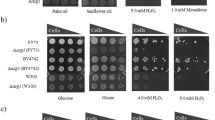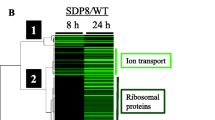Abstract
Transcription of genes for peroxisomal proteins is repressed by glucose and induced by oleate. At least for the peroxisomal thiolase gene (POT1) there is a third regulatory mechanism, mediated by the transcription factor Adr1p, which is responsible for the high-level expression of the gene in stationary phase. Here we show that a region in thePOT1 promoter that extends from positions −238 to −152 mediates this mechanism, and we suggest that Adr1p acts indirectly onPOT1. We have also analyzed the role of the cAMP-dependent protein kinase (PKA) in the transcriptional regulation ofPOT1. PKA exerts a negative control: the high, unregulated PKA activity in abcy1 mutant maintainsPOT1 transcription at the repressed level. In aras2 mutant, which has low PKA activity, glucose repression is not alleviated but in non-repressing conditionsPOT-1 regulation is perturbed and expression prematurely increases during exponential phase. This suggests that the PKA signalling pathway controls the regulation ofPOT1 in stationary phase. Finally, we have found that Adr1p-dependent expression in stationary phase and induction by oleate are both abolished when respiration is blocked. Utilization of fatty acids as carbon source requires respiration. Our result points to the existence of mechanisms that co-ordinate the level of expression of thiolase and the functional state of the mitochondria.
Similar content being viewed by others
References
Broach JR (1991)RAS genes inSaccharomyces cerevisiae: signal transduction in search of pathway. Trends Genet 7:28–33
Celenza JL, Carlson M (1986) A yeast gene that is essential for release from glucose repression encodes a protein kinase. Science 233:1175–1180
Chelstowska A, Butow RA (1995)RTG genes in yeast that function in communication between mitochondria and the nucleus are also required for expression of genes encoding peroxisomal proteins. J Biol Chem 270:18141–18146
Cheng CH, Kacherovsky N, Dombeck KM, Camier S, Thukral SK, Rhim F, Young ET (1994) Identification of potential target genes for Adr1p through characterization of essential nucleotides in UAS1. Mol Cell Biol 14:3842–3852
Denis CL, Audino DC (1991) The CCR1 (SNF1) and SCH9 protein kinases act independently of cAMP-dependent protein kinase and the transcriptional activator ADR1 in controlling yeastADH2 expression. Mol Gen Genet 229:395–399
Denis CL, Young ET (1983) Isolation and characterization of the positive regulatory geneADR1 fromSaccharomyces cerevisiae. Mol Cell Biol 3:360–370
Einerhand AWC, Voorn-Brouwer TM, Erdmann R, Kunau WH, Tabak HF (1991) Regulation of transcription of the gene coding for peroxisomal 3-oxoacyl-CoA thiolase ofSaccharomyces cerevisiae. Eur J Biochem 200:113–122
Einerhand AWC, van der Leij I, Kos WT, Distel B, Tabak HF (1992) Transcriptional regulation of genes encoding proteins involved in biogenesis of peroxisomes inSaccharomyces cerevisiae. Cell Biochem Funct 10:185–191
Einerhand AWC, Kos WT, Distel B, Tabak HF (1993) Characterization of a transcriptional control element involved in proliferation of peroxisomes in yeast in response to oleate. Eur J Biochem 214:323–331
Einerhand AWC, Kos WT, Smart WC, Kal AJ, Tabak HF, Cooper TG (1995) The upstream region of theFOX3 gene encoding peroxisomal 3-oxoacyl-coenzyme A thiolase inSaccharomyces cerevisiae contains ABF1-and replication protein A-binding sites that participate in its regulation by glucose repression. Mol Cell Biol 15:3405–3414
Erdmann R, Wiebel FF, Flessau A, Rytka J, Beyer A, Frohlich KU, Kunau WH (1991)PAS1, a yeast gene required for peroxisome biogenesis, encodes a member of a novel family of putative ATPases. Cell 64:499–510
Filipits M, Simon MM, Rapatz W, Hamilton B, Ruis H (1993) ASaccharomyces cerevisiae upstream activating sequence mediates induction of peroxisome proliferation by fatty acids. Gene 132:49–55
Fournier B, Smeitink JA, Dorland L, Berger R, Saudubray JM, Poll-The BT (1994) Peroxisomal disorders: a review. J Inherit Metal Dis 17:470–486
Goldring ES, Grossman LI, Krupnick D, Cryer DR, Marmur J (1970) The petite mutation in yeast. J Mol Biol 52:323–335
Guarente L (1983) Yeast promoters andlacZ fusions designed to study expression of cloned genes in yeast. Methods Enzymol 101:181–191
Hardy TA, Huang D, Roach PJ (1994) Interactions between cAMP-dependent and SNF1 protein kinase in the control of glycogen accumulation inSaccharomyces cerevisiae. J Biol Chem 269:27907–27913
Hiltunen JK, Wenzel B, Beyer A, Erdmann R, Fossa A, Kunau WH (1992) Peroxisomal multifunctionalβ-oxidation protein ofSaccharomyces cerevisiae. J Biol Chem 267:6646–6653
Hohfeld J, Veenhuis M, Kunau WH (1991)PAS3, aSaccharomyces cerevisiae gene encoding a peroxisomal integral membrane protein essential for peroxisome biogenesis. J Cell Biol 114:1167–1178
Hubbard EJA, Yang X, Carlson M (1992) Relationship of the cAMP-dependent protein kinase pathway to the SNF1 protein kinase and invertase expression inSaccharomyces cerevisiae. Genetics 130:71–80
Igual JC, Matallana E, Gonzalez-Bosch C, Franco L, Perez-Ortin JE (1991) A new glucose-repressible gene identified from the analysis of chromatin structure in deletion mutants of yeastSUC2 locus. Yeast 7:379–389
Igual JC, Gonzalez-Bosch C, Franco L, Perez-Ortin JE (1992) ThePOT1 gene for yeast peroxisomal thiolase is subject to three different mechanism of regulation. Mol Microbiol 6:1867–1875
Kunau WH, Hartig A (1992) Peroxisome biogenesis inSaccharomyces cerevisiae. Antonie van Leeuwenhock 62:63–78
Liao X, Butow RA (1993)RTG1 andRTG2: two yeast genes required for a novel path of communication from mitochondria to the nucleus. Cell 72:61–71
Liao X, Small WC, Srere PA, Butow RA (1991) Intramitochondrial functions regulate nonmitochondrial citrate synthase (CIT2) expression inSaccharomyces cerevisiae. Mol Cell Biol 11:38–46
Miller JH (1972) Experiments in molecular genetics. Cold Spring Harbor Laboratory Press, Cold Spring Harbor, New York
Navarro B, Igual JC (1994)ADR1 andSNF1 mediate different mechanisms in transcriptional regulation of yeastPOT1 gene. Biochem Biophys Res Commun 202:960–966
Parikh VS, Morgan MM, Scott R, Clemens LS, Butow RA (1987) The mitochondrial genotype can influence nuclear gene expression in yeast. Science 235:576–580
Pavlik P, Simon M, Schuster T, Ruis H (1993) The glycerol kinase (GUT1) gene ofSaccharomyces cerevisiae: cloning and characterization. Curr Genet 24:21–25
Purdue PE, Lazarow PB (1994) Peroxisomal biogenesis: multiple pathways of protein import. J Biol Chem 269:30065–30068
Ronne H (1995) Glucose repression in fungi. Trends Genet 11:12–17
Sarokin L, Carlson M (1985) Upstream region of theSUC2 gene confers regulated expression to a heterologous gene inSaccharomyces cerevisiae. Mol Cell Biol 5:2521–2526
Schulz H (1991)β-Oxidation of fatty acids. Biochim Biophys Acta 1081:109–120
Simon M, Adam G, Rapatz W, Spevak W, Ruis H (1991) TheSaccharomyces cerevisiae ADR1 gene is a positive regulator of transcription of genes encoding peroxisomal proteins. Mol Cell Biol 11:699–704
Simon M, Binder J, Adam G, Hartig A, Ruis H (1992) Control of peroxisome proliferation inSaccharomyces cerevisiae byADR1, SNF1 (CAT1, CCR1) andSNF4 (CAT3). Yeast 8:303–309
Tatchell K, Chaleff DT, Defeo-Jones D, Scolnick EM (1984) Requirement of either of a pair ofRAS-related genes ofSaccharomyces cerevisiae for spore viability. Nature 309:523–527
Thevelein JM (1994) Signal transduction in yeast. Yeast 10:1753–1790
Thompson-Jaeger S, Francois J, Gaughran JP, Tatchell K (1991) Deletion ofSNF1 affects the nutrient response of yeast and resembles mutations which activate the adenylate cyclase pathway. Genetics 129:697–706
Toda T, Cameron S, Sass P, Zoller M, Scott JD, McMullen B, Hurwitz M, Krebs EG, Wigler M (1987) Cloning and characterization ofBCY1, a locus encoding a regulatory subunit of the cyclic AMP-dependent protein kinase inSaccharomyces cerevisiae. Mol Cell Biol 7:1371–1377
Treinin M, Simchen G (1993) Mitochondrial activity is required for the expression ofIME1, a regulator of meiosis in yeast. Curr Genet 23:223–227
Van der Bosch H, Schutgens RBH, Wanders RJA, Tager JM (1992) Biochemistry of peroxisomes. Annu Rev Biochem 61:157–197
van der Leij I, van der Berg M, Boot R, Franse M, Distel B, Tabak HF (1992) Isolation of peroxisome assembly mutants forSaccharomyces cerevisiae with different morphologies using a novel positive selection procedure. J Cell Biol 119:153–162
Veenhuis M, Harder W (1991) Microbodies. In: Rose AH, Harrison JS (eds) The yeasts 2nd edn, vol. 4. Academic Press, London-San Diego, pp 601–653
Veenhuis M, Mateblowski M, Kunau WH, Harder W (1987) Proliferation of microbodies inSaccharomyces cerevisiae. Yeast 3:77–84
Wang TW, Lewin AS, Small GM (1992) A negative regulating element controlling transcription of the gene encoding acyl-CoA oxidase inSaccharomyces cerevisiae. Nucleic Acids Res 20:3495–3500
Wang T, Luo Y, Small GM (1994) ThePOX1 gene encoding peroxisomal acyl-CoA oxidase inSaccharomyces cerevisiae is under the control of multiple regulatory elements. J Biol Chem 269:24480–24485
Werner-Washburne M, Braun E, Johnston GC, Singer RA (1993) Stationary phase in the yeastSaccharomyces cerevisiae. Microbiol Rev 57:383–401
Author information
Authors and Affiliations
Additional information
Communicated by C. P. Hollenberg
Rights and permissions
About this article
Cite this article
Igual, J.C., Navarro, B. & Igual, J.C. Respiration and low cAMP-dependent protein kinase activity are required for high-level expression of the peroxisomal thiolase gene inSaccharomyces cerevisiae . Molec. Gen. Genet. 252, 446–455 (1996). https://doi.org/10.1007/BF02173010
Received:
Accepted:
Issue Date:
DOI: https://doi.org/10.1007/BF02173010




